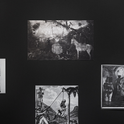When is a self-portrait not a self-portrait? When it's not painted by its subject, you might be tempted to answer. But you'd be wrong. According to the latest findings of the Rembrandt Research Project, half of Rembrandt's self-portraits were not by Rembrandt. Aside from presenting the mind with an amusing semantic puzzle, the idea of a self-portrait painted by a third party lights the fuse of a stick of art history dynamite. But it's not clear quite what will be demolished in the explosion.
The Rembrandt Research Project (RRP) is one of the most august and long-standing art history investigations ever mounted. Begun in 1968, it was not supposed to last for 40 years, and has done so principally because of the unattainability of its goal. For over a century the authenticity of large numbers of paintings by Rembrandt has been disputed. Many, it has been argued, were painted by his team of highly skilled studio assistants. The RRP was established to provide a definitive attribution of every painting by Rembrandt using every method available. It spent the first three decades of its work disattributing many Rembrandts, and it has spent the last decade re-attributing. So its activities are a wonderful testament to the unique fogginess of art historical scholarship. It shows that with Rembrandt, as with so many other artists, we will never really know which works they made themselves and which they got their employees to do.
Although connoisseurs and art historians have long explored the question of Rembrandt's self-portraits, the findings of RRP chairman, Ernst van de Wetering, and his colleagues represent the most extreme formulation yet of the minimalist case. There are around 50 Rembrandt self-portrait paintings, around 30 etchings and five to ten drawn self-portraits, which in total amounts to around 10 per cent of Rembrandt's entire painted and etched oeuvre—an incredible proportion. But the RRP has concluded that only 33 of the paintings, four of the etchings and two or three of the drawings are actual "portraits of Rembrandt by himself." An equally incredible proportion.
Until recently, the Rembrandt self-portrait symbolised the singularity of the modern artist. Here was the first painter self-consciously to peer inside his soul, confronting his genius over and again, in front of the mirror across the whole length of his long life. Except, of course, that he didn't.
The RRP has found that Rembrandt got his assistants to make the portraits to cater for the growing market in Rembrandt self-portraits. He kept a stack of them in his studio, ready to sell to collectors who came to visit him. X-rays have shown that they were sometimes amended at later dates to make Rembrandt look older—so that customers who wanted a self-portrait got one that looked like the artist-genius they'd met that day, not a younger man. And it now turns out that even many of those "Rembrandts" that have long been considered outright fakes were made from inside his studio, and not outside it as previously thought. Depending on how you extend the claim of the artist's authorship, there may be more, not fewer, Rembrandts than we thought.
What does all this mean? If we take the RRP's conclusions at face value, it means that the 17th-century art market had some of the characteristics it has today. There was a European elite of big-name collectors—nobles and merchants—who simply had to own certain works. Just as a modern collector might decide he or she needs a Damien Hirst spin painting or Warhol screen print, in those days they had to have a Rembrandt self-portrait. Often these people weren't particularly bright or discerning, so the artist could flog them a third-rate studio work as an original. Viewed from this perspective, the cynical marketing guile of contemporary artists does not look like the perversion of artistic creativity some critics would have us believe.
Instead, the odd thing is what has happened in the intervening four centuries: the fetishisation of the artist's physical authorship of the work. This was an ideological product of Romanticism, which set up the idea of art, emotion and spiritual revelation as the opposite of reason, and therefore of technology and industry. Now those ideas are dead and artists can go back to turning out a branded product range, defined by its style and message, not by their personal execution of the work.
But what if we don't take the findings of the RRP at face value? They have pushed the arguments against Rembrandt's authorship as far as they can go. The fact that assistants painted many of the self-portraits doesn't mean that the ones Rembrandt painted himself are not unique, and there are still enough original self-portraits to argue that these works were a milestone in the evolution of the soul-searching modern European man. The RRP's demystifying capitalist thesis fits just a little too neatly into the way contemporary art is produced. As the historian and philosopher RG Collingwood said, every age must rewrite history in its own way. So instead of demolishing the myth of Rembrandt, the RRP's stick of dynamite may be reminding us that this adage is no less true of art history, and that we are now merely looking at what we want to see, which is an image of studio production, rather than of genius.











